Embarking on the Daily 5 journey in your classroom can be a transformative experience, offering students significant choice and building their literacy independence. It is a framework designed to foster a love for reading and writing, allowing children to engage deeply with various literacy tasks while the teacher works with small groups or individual students. This approach empowers students to take ownership of their learning, creating a dynamic and student-centered environment that buzzes with productive activity.
However, like any well-orchestrated system, the Daily 5 requires thoughtful planning to ensure smooth transitions, effective instruction, and maximum student engagement. Without a clear structure, the wonderful freedom it offers could quickly descend into chaos. That is where a robust and adaptable daily 5 lesson plan template becomes an invaluable tool, providing the organizational backbone needed to manage the diverse activities and individual needs of your students efficiently. It helps you visualize your entire literacy block, ensuring every minute is purposeful and productive for both you and your learners.
Understanding the Core of Daily 5 Planning
The Daily 5 framework, developed by Gail Boushey and Joan Moser, known as The Sisters, is more than just a set of activities; it is a system for fostering independence and stamina in reading and writing. It centers on five key components: Read to Self, Work on Writing, Read to Someone, Listen to Reading, and Word Work. The beauty of this model lies in its ability to allow students to practice literacy skills independently while the teacher is free to conduct targeted small group instruction or individual conferences, addressing specific learning needs with precision.
Each of these five components is introduced through mini-lessons that build student stamina and understanding of expectations. Students then apply these skills during independent work time. For instance, after a mini-lesson on selecting a “just right” book, students might engage in Read to Self for an extended period, gradually increasing their reading stamina. Meanwhile, other students might be working on their writing pieces, collaborating with a partner, or deepening their vocabulary through Word Work activities.
The teacher’s role within this framework is crucial. Rather than leading whole-class instruction for the entire block, the teacher cycles through conferring with individual students, pulling small groups for targeted lessons based on assessed needs, and observing student engagement. This requires a high degree of organization and foresight, making the act of planning paramount. A good template ensures that these vital interactions are scheduled and that all students are receiving appropriate attention and instruction.
Integrating the Daily 5 effectively means considering how each component feeds into your overall literacy goals. It is about creating a flexible yet consistent routine that allows for differentiation, assessment, and ongoing student growth. This comprehensive approach to literacy instruction truly shines when supported by meticulous planning, allowing you to track progress and adjust your strategies as needed.
Key Elements to Include in Your Template
- Mini-lesson focus and teaching point
- Student group rotations and assignments for each Daily 5 choice
- Scheduled individual conferring times
- Specific materials needed for each station
- Assessment notes or observation points
Benefits of a Structured Template
- Ensures consistency in routine and expectations
- Provides clarity for both teacher and students
- Facilitates efficient time management during the literacy block
- Supports effective differentiation for diverse learners
- Offers a record for reflection and future planning
Crafting Your Perfect Daily 5 Schedule
Designing your Daily 5 schedule involves more than just plugging in activities; it requires thoughtful consideration of your students’ needs, your instructional goals, and the natural flow of your classroom day. While the core components remain the same, the sequence and duration of each segment can be adapted to fit your particular context. For example, some teachers prefer to start with a mini-lesson followed by one or two Daily 5 rotations, while others might cycle through all five choices in a single block over several days.
Flexibility is key. While a template provides a framework, be prepared to adjust it based on student engagement, unforeseen interruptions, or emerging instructional needs. Observe your students carefully during their independent work time. Are they truly engaged in their chosen activity? Are they making productive use of their time? This continuous assessment will inform adjustments to your schedule, rotation groups, or even the mini-lessons you plan for the following days.
The goal is to create a dynamic literacy block where students feel empowered and productive. A well-designed daily 5 lesson plan template will help you visualize this flow, ensuring smooth transitions between activities and maximizing instructional time. It provides a roadmap, allowing you to be present with your students, focusing on their learning rather than scrambling to remember what comes next.
- Plan engaging mini-lessons that explicitly teach strategies for each Daily 5 component.
- Establish clear expectations and routines for transitions between choices.
- Differentiate student groups based on specific reading and writing needs.
- Prepare all necessary materials in advance to avoid wasting precious instructional time.
- Build in opportunities for quick check-ins or share sessions to maintain accountability and celebrate learning.
Ultimately, a well-crafted daily 5 lesson plan template transforms your intentions into actionable steps, creating a clear pathway for literacy growth in your classroom. It empowers you to maximize student independence, provide targeted instruction, and cultivate a vibrant learning community where every child thrives as a reader and writer. By consistently using and refining your planning tool, you will see remarkable progress in your students’ literacy skills and their overall enthusiasm for learning.


